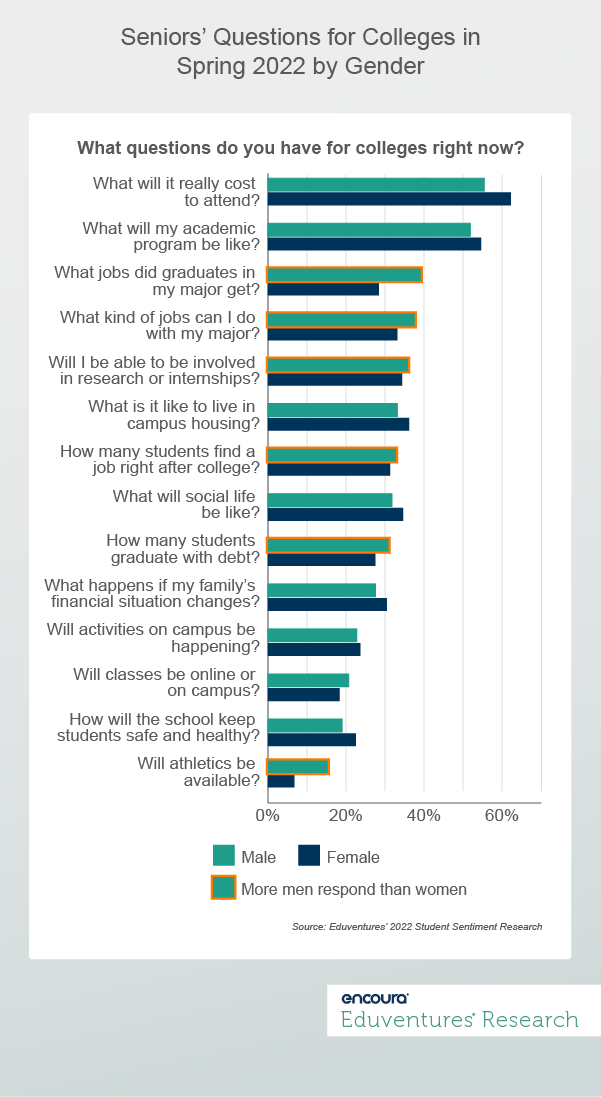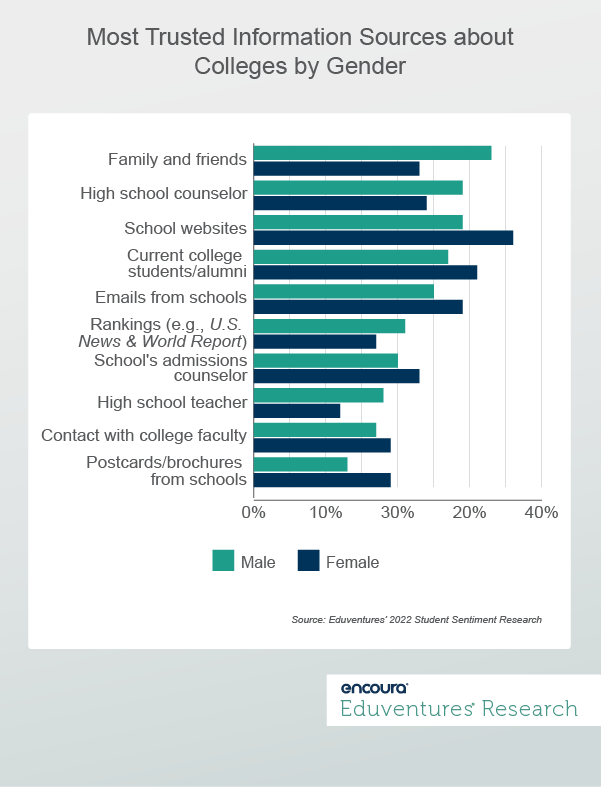Where are all the men? This question is currently on the minds of many enrollment officers. While male enrollment in higher education has trailed female enrollment for decades now, the pandemic widened the gender gap dramatically. The National Student Clearinghouse reported that undergraduate enrollment among male students dropped by 5.5% between spring 2020 and spring 2021, compared to a more moderate 2% decline among women.
Why are men shying away from college? And what could bring them back? These are not easy questions, and we certainly don’t have all the answers, but Eduventures’ latest Student Sentiment Research™ may provide some clues. Here’s a sneak peek at some of the findings we’ll explore in-depth at Eduventures Summit, June 15-17.
The Cost-Benefit Analysis
Eduventures’ Student Sentiment Research, now in its fifth year, examines student search behaviors and preferences for institutional outreach. While this study has always provided valuable information about key marketing channels used for recruiting, in the wake of the COVID-19 pandemic, it also explores the key questions on students’ minds. The data, which was collected in March of 2022, provides valuable insights into how students are thinking about one of the most important decisions of their academic careers: where to enroll.
Which topics should schools focus their communications on to stay connected and possibly ease enrollment worries? (Figure 1).

A majority of both men and women share an interest in the top two questions: how much will college really cost, and what will their academic program be like? At the time of data collection, financial aid letters had begun arriving in mailboxes, giving families a better idea of the cost of attendance for at least the first year of school. Yet, cost remained the top question on students’ minds, perhaps indicating an uncertainty about the total cost across all four years of college, hidden costs not addressed in the financial aid letter such as books and living expenses, or possibly confusion about the financial aid offers themselves.
Interestingly, women tend to worry more often about cost while men are more likely to wonder about job outcomes. Men more often want to know what types of jobs their majors will lead to (38% male vs. 33% female), and they particularly want to know about the actual career paths taken by graduates (39% vs. 28%). In other words, men seem to want to know whether it will all be worth it from a highly pragmatic perspective.
For institutions looking to enroll more men, connecting the major-to-career dots and giving compelling examples is paramount to convincing male admits that it will all be worth it. But this can be easier said than done.
Approaches to College Search
Another clue to understanding the gender gap may be found in differences between how male and female prospects conduct their college searches in the first place. Examining the answers students gave to our questions about college search activities reveals, as it has in previous years, that men are overall less active than women. While women are more likely to proactively avail themselves of the many information sources that are accessible to students, men, on average, tend to be more reactive to the outreach directed at them.
Perhaps this indicates a difference in maturity level and preparedness, but it certainly creates a challenge for the institutions seeking more male prospects. How can they build a connection with male students if they are less likely to engage in search behaviors that translate to inquiries, such as requesting information on a college’s website or interacting on social media? Where do male prospects get their information about college?

Figure 2 shows that men rely more on trusted individuals from their own personal circles like family and friends (trusted by 33% male vs. 23% female), high school teachers (18% vs. 12%), and counselors (29% vs. 24%). Less trusted are sources originating within the institutions trying to recruit these students, including college websites (29% male vs. 36% female), print materials (13% vs. 19%), current students (27% vs. 31%), or admissions counselors (20% vs. 23%). Again, we believe this points to a less proactive search approach by men who more often defer to people in their immediate personal orbits. The question is, if men are more passive in their college search, how can institutions reach them?
The Bottom Line
Men are not pursuing college at the same rate as women. Among the possible reasons for this, as our data shows, include less proactive college search approaches and greater uncertainty about how higher education will lead to the desired outcome. For men, this may be more directly tied to career success and return on investment. Institutions that are trying to engage more men should consider the following strategies:
Build connections with a student’s network. Men are less self-directed in their college searches and seem happy to let trusted individuals take the lead. Because of this, a solid strategy to recruit more men should always include those individuals. Parent communication may be the key to engaging more men at an earlier recruitment stage, and good connections with feeder high schools also seem vitally important.
Focus on career. Return on investment is critically important to male students. Many questions around cost and career preparation and outcomes still exist when high school seniors make their enrollment decisions, and possibly beyond. Recruitment communication and on-campus events should continue to address these questions throughout the later recruitment stages. Further, once students are on campus, the career connection needs to remain visible.
We have only just begun to explore the newest Student Sentiment data. Join us at Eduventures Summit in June to learn more about the research and how student college search has changed over the course of the COVID-19 pandemic.
Never Miss Your Wake-Up Call
Learn more about our team of expert research analysts here.
Eduventures Senior Analyst at Encoura
Contact
The Program Strength Assessment (PSA) is a data-driven way for higher education leaders to objectively evaluate their programs against internal and external benchmarks. By leveraging the unparalleled data sets and deep expertise of Eduventures, we’re able to objectively identify where your program strengths intersect with traditional, adult, and graduate students’ values, so you can create a productive and distinctive program portfolio.
This recruitment cycle challenged the creativity of enrollment teams as they were forced to recreate the entire enrollment experience online. The challenge for this spring will be getting proximate to admitted students by replicating new-found practices to increase yield through the summer’s extended enrollment cycle.
By participating in the Eduventures Admitted Student Research, your office will gain actionable insights on:
- Nationwide benchmarks for yield outcomes
- Changes in the decision-making behaviors of incoming freshmen that impact recruiting
- Gaps between how your institution was perceived and your actual institution identity
- Regional and national competitive shifts in the wake of the post-COVID-19 environment
- Competitiveness of your updated financial aid model

